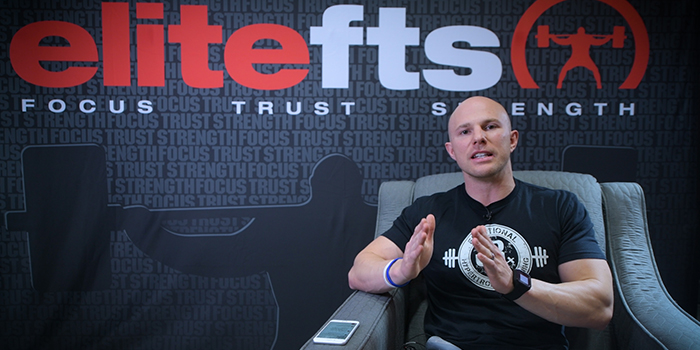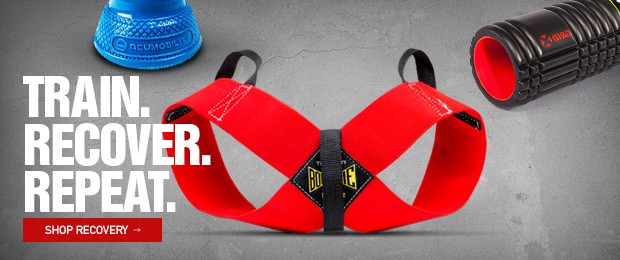
Through the Fixing Dave Tate series, we have learned a lot about Dr. John Rusin's beliefs on training and function of the human body. He has explained in detail the process he and Dave have gone through to improve his training and daily life, and now in this video below, Dr. Rusin responds questions directly from you, the readers of elitefts.
"What are your thoughts on foam rolling pre-workout or in the pre-warm-up or post-warm-up?"
Foam rolling is in the six-phase dynamic warm-up sequence used at the beginning each of Dave's training sessions. Foam rolling is the first item in this sequence, but Dr. Rusin cautions you to beware the trap of spending too much time foam rolling every part of your body. Find the lynchpins and go after them for one to two minutes.
"Can you speak for more than two minutes without dropping an F-Bomb?"
Well, sure. And there are times that Dr. Rusin does so. But the Fixing Dave Tate series is a real, organic experience that involves authentic conversation. It's how coaches speak on a day-to-day basis. This isn't the same behavior you're going to experience from Dr. Rusin if he's presenting at a research symposium, but this is the way that he coaches and anything else would be fake.
"Advice for programming the deadlift around a disc herniation?"
A disc herniation is not a death sentence in your training or a death sentence in your movement. There are a lot of ways to adjust your training but the first thing to always remember is that you are not your MRI.
"What are the best things you've done to grow as a professional?"
The number one thing Dr. Rusin has done to further his knowledge and career is learning from professionals outside of his niche specialty. His perspective is that you need to become a generalist before you can become a great specialist, so learn from many different areas of the fitness industry.
"What are some benchmarks for core strength?"
For Dr. Rusin, it's all about dominating the pillar complex and integrating the shoulders, hips, and core as a single unit. The best method he's seen for testing this is loaded carries. Carrying 200% of your bodyweight for 30 seconds would be elite strength in this movement.
"How would you address imbalances as a result of lifting?"
The first thing to know is that imbalances are not only a result of lifting but are also a result of being a human being. The way you sit on a daily basis often has more of an impact on your body than what you do for 90 minutes in the gym. A good rule of thumb to combat the issues that arise from this lifestyle is to do three times as much pulling as you do pushing, and two times as much horizontal pulling as vertical pulling.
"What type of training split and training volume do you recommend for women trying to stabilize and strengthen their shoulder and their scapula?"
Well, you can't strengthen the shoulder or scapula. They aren't muscles. But there are 17 muscles that attach into the scapula. These are tiny intricate muscles that can be trained on a daily basis. Bring your shoulders back into retraction, downward rotation, and depression before each session of physical activity.
"How much pain is okay to ignore?"
You should never ignore pain, but some pain is okay to train through. People have day-to-day chronic pains, but if you have pathological pain that you would rank at eight, nine, or 10 on a 10-point scale, you need to do something to address it. You only get one body, and you need to respond to its indicators that something is wrong.
"Would you suggest that more powerlifters need to utilize single-leg movements for glute activation like you talked about with Dave?"
Singe-leg training is about more than just glute activation, and it's something that's terribly important for powerlifters as bilateral-dominant athletes. You don't need to go heavy on these, and sometimes just putting single-leg movements into the mix can lead to improvement in stability.
"How were you able to train consistently while in physical therapy school?"
You can be in school over 10 hours a day, but in the off time when other people are bullshitting around, what are you going to be doing? For Dr. Rusin, this time period was lunch, during which he would squeeze in his training sessions. If it's one of your top priorities, you simply find a way.
"What are the best ways to rehab inner elbow pain?"
General tendinitis of the elbows is very common, and can be combated by increased training of the grip. One of the best ways to combat your tendinitis is by training you arms, working your grip, and doing more carrying work.
"What are some of the best ways to rehab chronic shoulder pain?"
It's very important to place the vast majority of your shoulder training on your posterior chain, including band pull-aparts, face pulls, and rear delt flyes. If you've had chronic pain in your shoulders, you often need to step away from the bench press and begin rebuilding from the push-up position to rewire your neuromuscular system.
"What do you find more important to work on first: mobility or stability?"
Most people have a misunderstanding of the mobility-stability continuum and aren't able to identify if mobility or stability is the limiting factor. Dr. Rusin walks through the specifics of how this confusion develops, and how in most cases you should focus on stability first to lead to better movement.
"How do you asses, test, and screen your clients before putting together a program for them?"
Not every single assessment takes hours and hours like Dave's did. This is almost never feasible. But in a first session, you should spend up to half of the time collecting data on their movement patterns. In most cases, this goes from a functional movement screen to a dynamic warm-up.
"Hoping to get more specific recommendations for rest recovery days."
Active recovery can always stimulate better than passive recovery. A nice phasic system Dr. Rusin has used in the past is to begin with generalized foam rolling, then stretching on those same tissues, then some low intensity, low impact steady state cardio, followed by breathing exercises to finish.
"Best three exercise to train overall rotator cuff stability and strength?"
Following a detailed explanation of the rotator cuff anatomy and function, Dr. Rusin gives a simple recommendation: band over-and-backs, banded face pulls, and banded pull-aparts as a triset.
"How would you build up your referral network as a personal trainer?"
This one is easy: You should be training yourself. Who would you go to yourself? What chiro would you see? What physical therapist would you go to? That's who you want to send your clients to for treatment, which will result in them also sending clients your way.
For the final two questions of the video, Dr. Rusin discusses the mental shift that is required before a person is capable of making a physical shift in their lives, and then tells the story of how he became connected with Dave and with elitefts.
By the minute:
- (0:47) Foam rolling
- (3:15) F-Bombs
- (3:52) Programming the deadlift around a disc herniation
- (5:24) The number one thing Dr. Rusin has done for his career
- (6:45) Benchmarks for core strength
- (8:55) Addressing imbalances as a result of lifting
- (10:00) Stabilizing and strengthening the shoulder
- (11:36) How much pain is okay to ignore?
- (12:30) Single-leg training for powerlifters
- (14:36) Training during physical therapy school
- (16:15) Inner elbow pain
- (17:43) Rehabbing chronic shoulder pain
- (19:29) Mobility or stability first
- (21:43) Asses, testing, and screening
- (23:15) Rest recovery days
- (25:35) Rotator cuff strength
- (27:45) Building a referral network
- (29:20) Will your next set do something that
- (32:00) How Dr. Rusin became connected with Dave and elitefts









